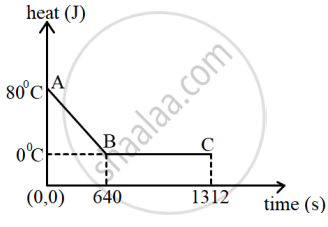Advertisements
Advertisements
Question
Describe a method to determine the specific heat capacity of a solid (say, a piece of copper).
Solution
First we weigh the given piece of solid and note its mass m1. Then it is heated by suspending it inside a heater. Then a known mass (say m2) of water is taken in a thin glass beaker and its temperature θ1 is recorded with a thermometer. When the given piece of solid becomes heated, its temperature θ2 is noted and it is quickly dropped into the water contained in the beaker, such that no water splashes out. The contents of beaker are well stirred and the final highest temperature θ3 is noted.
Assuming that the heat capacity of beaker is negligible and there is not heat loss to the surroundings,
Heat lost by the solid = Heat gained by water Mass of solid × Specific heat capacity of solid × Fall in temperature of solid = Mass of water × Sp. capacity of water × Rise in temperature of water.
or m1 × c × (θ2 - θ3) = m3 × 4.2 × (θ3 - θ1)
or c = `("m"_2 xx 4.2 xx (theta_3 - theta_1))/(theta_1 xx (theta_2 - theta_3))` J/g°C
Here we have assumed that specific heat capacity of water is 4.2 J/g°C.
APPEARS IN
RELATED QUESTIONS
What property of water makes it an effective coolant?
During the phase change does the average kinetic energy of the molecules of the substance increase?
How does green house effect help in keeping the temperature of earth’s surface suitable for living of human beings?
Define the term 'specific heat capacity' and state its unit.
State, with reason, which of the two, boiling water or steam both at 100°C will produce more severe burns.
An equal quantity of heat is supplied to two substances A and B. The substance A shows a greater rise in temperature. What can you say about the heat capacity of A as compared to that of B?
The diagram below shows a cooling curve for 200 g of water. The heat is extracted at the rate of 100 Js-1. Answer the questions that follow:

- Calculate specific heat capacity of water.
- Heat released in the region BC.
Two metals A and B have specific heat capacities in the ratio 2 : 3. If they are supplied the same amount of heat then
Which metal piece will show a greater rise in temperature given their masses is the same?
A metal ball of heat capacity 50J/°C loses 2000 J of heat. By how much will its temperature fall?
A block of ice of mass 120 g at temperature 0°C is put in 300 gm of water at 25°C. The xg of ice melts as the temperature of the water reaches 0°C. The value of x is ______.
[Use: Specific heat capacity of water = 4200 Jkg-1K-1, Latent heat of ice = 3.5 × 105 Jkg-1]
